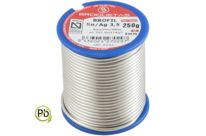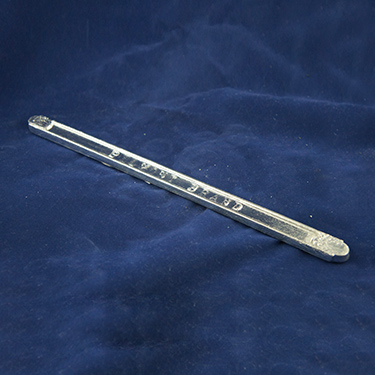For eutectic SnPb TM is 183C 456K and 12 TM 228K - 45C. Youngs modulus is given versus temperature in Table 15 and the data is plotted in Figure 34.
Lead Free Solder And Composition Lead Free Solder Wire Paste Bar
In electronics assembly the eutectic alloy with 63 tin and 37 lead or.
Tin lead solder material properties. Tin-Lead solders are compatible for use with all types of base metal cleaners fluxes and heating methods. It is also the bridge between the wetted surfaces holding the joint together. MS2 molten solder surfactant for use with standard Sn60 and Sn63 tin-lead solder processes.
Other properties of interest for predictive modeling of solder joint geometry using for example a computer program such as Surface Evolver are. Even at room temperature solder joints exhibit both creep and fatigue behavior that is strongly dependent on solder joint configuration the thermal environment and the solder alloy properties. Physical and Mechanical Properties of Lead-Free Alloys and Sn-37Pb eutectic Table 119.
60-40 solder provides strong and reliable joints under a variety of environmental conditions. Solder density in lbin 3 or gcm 3. This particular alloys is used as a solder in used in electronics because of its very low melting point.
80 rows Solder Alloy. The microstructures of solder joints with up to 25 years of aging have been studied using SEMEDS and metallographic techniques. 75 NIST Boulder database.
Strength and Hardness of Soft Solder. This product contains lead. Tin itself has a very low melting point tin alloyed with lead forms a eutectic mixture at the weight proportion of 619 tin and 381 lead with melting temperature of 183 C 3614 F.
Makeup of solder joint. The higher melting points of the lead-free alloys also dictate higher processing temperatures and usually higher contact times. It also provides good electrical properties as well as mechanical strength.
In Japan the Japan Electronic Industry Development Association JEIDA has recommended 965wtSn-. Properties of Soft Solder. Tin has long been used in alloys with lead as solder.
When the solder serves as a link between the metals to be joined the bulk-solder properties become important since they determine the property of the entire joint see Fig. Soldering is a technique for joining metals using a filler metal alloy that has a melting temperature less than about 425C 800F. The last stage of deformation is tertiary creep where strain rates increase rapidly until the test specimen ruptures.
Like pure tin it is bright hardly tarnishes is lead-free and non-toxic but unlike pure tin it is relatively strong. Mechanical Properties of Tin Tin-Lead and Four Lead-Free Solder Alloys by Ring-and-Plug Tests Table 117. 6040 Tin Lead solder almost the eutectic is particularly adaptable to delicate work or when soldering temperature may be critical.
That is standard SnPb solder readily creeps at and well below room temperature. The density of gold is 193 gcc and the density of eutectic tin-lead solder is 846 gcc 2. 96S TINSILVER SOLDER Multicore 96S alloy is the pure tinsilver eutectic alloy.
And Foreign Patents Pending 1. Soldering is a technique for joining metals using a filler metal alloy that has a melting temperature less than about 425C 800F. Small amounts of various metals notably antimony and silver are added to tin-lead solders to increase their strength.
Melting Point C solidus liquidus. Plot of SAC Youngs Modulus E MPa versus temperature T K. Typical Cu joint is 200 MPa.
Solder is the largest use for tin in the US. The advent of lead-free soldering has resulted in the introduction of a number of high tin solder alloys which for selective soldering applications typically means solders with melting temperatures in excess of 220C. MATERIAL SAFETY DATA SHEET MS2 100 PB Molten Solder Surfactant US.
Better placement accuracy may be needed due to less self centering of lead free alloys when molten AOI Recalibration. The solder ensures that electronic components are joined securely to contact points. As can be seen from the above table the 63 tin 37 lead solder alloy results in the.
60-40 solder provides strong and reliable joints under a variety of environmental conditions. Shear Strength Typical soldered Cu joint is 55 MPa. Tin promotes adhesion to many base metals.
The solder has an additional function however. Tin has long been used in alloys with lead as solder. Such solders are primarily used for joining pipes or electric circuits.
Not recommended for use with lead-free solder processes. Shear Strengths Solidus and Liquidus Temperatures and Wetting Angles of Experimental Sn-Ag-Cu Solder Alloys. Sn-Ag-Cu alloy is considered the preferred substitute for tin-lead solder in reflow applications due to its relatively low melting temperature and superior mechanical properties and solderability compared with other lead free solders.
6040 Tin Lead Alloy. Little change rheological properties do not change lower metal Pick Place Equipment Little impact. The tin lead wire solder is commonly used for electronics where heat sensitive components will begin to melt crack or warp at varying high temperatures.
A SMT PWB is specified to have 30 microinches of electroplated gold over 100 microinches minimum of nickel. There are also high-tin solders which are used for joining parts of electrical apparatuses because their electrical conductivity is higher than that of high-lead solders. For the two Sn-Ag-Cu alloys the data was digitized from Figure 2 in Schubert et al 2001.
It has higher electrical conductivity than other soft solders and a melting point approximately 40C higher than either 6040 6337 or LMP alloys. Product and Company Identification Commercial Description. Tin itself has a very low melting point tin alloyed with lead forms a eutectic mixture at the weight proportion of 619 tin and 381 lead with melting temperature of 183 C 3614 F.
There are also high-tin solders which are used for joining parts of electrical apparatuses because their electrical conductivity is higher than that of high-lead solders. Tin-Lead solders is the largest single group and the most widely used of the soldering alloys. These calculations will be illustrated for the following example.
Of a material data sheet. Tensile Strength Ultimate Cast solder. Joints are duller in appearance and less reflective Reflow.
Because of this lower temperature and different alloys used as fillers the metallurgical reaction between filler and work piece is minimal resulting in a weaker joint.

Tin Wire For Electronic Soldering Eco 1 Contact Broquetas Sl

60 40 Tin Lead Solder Wire Belmont Metals
Tidak ada komentar